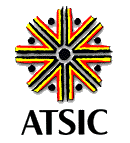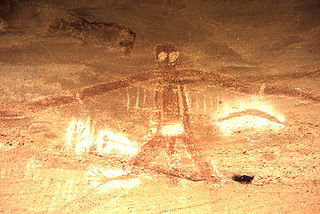
The Aboriginal and Torres Strait Islander Commission (ATSIC) (1990–2005) was the Australian Government body through which Aboriginal Australians and Torres Strait Islanders were formally involved in the processes of government affecting their lives, established under the Hawke government in 1990. A number of Indigenous programs and organisations fell under the overall umbrella of ATSIC.
Native title is the designation given to the common law doctrine of Aboriginal title in Australia, which is the recognition by Australian law that Indigenous Australians have rights and interests to their land that derive from their traditional laws and customs. The concept recognises that in certain cases there was and is a continued beneficial legal interest in land held by Indigenous peoples which survived the acquisition of radical title to the land by the Crown at the time of sovereignty. Native title can co-exist with non-Aboriginal proprietary rights and in some cases different Aboriginal groups can exercise their native title over the same land.

The second question of the 1967 Australian referendum of 27 May 1967, called by the Holt government, related to Indigenous Australians. Voters were asked whether to give the Federal Government the power to make special laws for Indigenous Australians in states, and whether in population counts for constitutional purposes to include all Indigenous Australians. The term "the Aboriginal Race" was used in the question.

Commonwealth v Tasmania was a significant Australian court case, decided in the High Court of Australia on 1 July 1983. The case was a landmark decision in Australian constitutional law, and was a significant moment in the history of conservation in Australia. The case centred on the proposed construction of a hydro-electric dam on the Gordon River in Tasmania, which was supported by the Tasmanian government, but opposed by the Australian federal government and environmental groups.
Section 51(xxvi) of the Constitution of Australia, commonly called "the race power", is the subsection of Section 51 of the Constitution of Australia granting the Australian Commonwealth the power to make special laws for people of any race.

The Hindmarsh Island bridge controversy was a 1990s Australian legal and political controversy that involved the clash of local Aboriginal Australian sacred culture and property rights. A proposed bridge to Hindmarsh Island, near Goolwa, South Australia attracted opposition from many local residents, environmental groups and indigenous leaders. In 1994, a group of Ngarrindjeri women elders claimed the site was sacred to them for reasons that could not be revealed. The case attracted much controversy because the issue intersected with broader concerns about Indigenous rights, specifically Aboriginal land rights, in the Australian community at the time, and coincided with the Mabo and Wik High Court cases regarding Native title in Australia.
Elizabeth Andreas Evatt, an eminent Australian reformist lawyer and jurist who sat on numerous national and international tribunals and commissions, was the first Chief Justice of the Family Court of Australia, the first female judge of an Australian federal court, and the first Australian to be elected to the United Nations Human Rights Committee.

The Aboriginals Protection and Restriction of the Sale of Opium Act 1897(Qld), was an Act of the Parliament of Queensland. It was the first instrument of separate legal control over Aboriginal peoples, and was more restrictive than any contemporary legislation operating in other states. It also implemented the creation of Aboriginal reserves to control the dwelling places and movement of the people.

An Australian Aboriginal sacred site is a place deemed significant and meaningful by Aboriginal Australians based on their beliefs. It may include any feature in the landscape, and in coastal areas, these may lie underwater. The site's status is derived from an association with some aspect of social and cultural tradition, which is related to ancestral beings, collectively known as Dreamtime, who created both physical and social aspects of the world. The site may have its access restricted based on gender, clan or other Aboriginal grouping, or other factors.
Australian heritage laws exist at the national (Commonwealth) level, and at each of Australian Capital Territory, New South Wales, Northern Territory, Queensland, South Australia, Tasmania, Victoria, Western Australia state and territory levels. Generally there are separate laws governing Aboriginal cultural heritage and sacred sites, and historical heritage. State laws also allow heritage to be protected through local government regulations, such as planning schemes, as well.
The Aboriginal Cultural Heritage Act 2003 is legislation passed by Queensland Parliament, commencing in April 2004 to recognise, protect and conserve Aboriginal cultural heritage in the State of Queensland
The National Parks and Wildlife Act 1974 is the legislation passed by the New South Wales Parliament with the explicit intent of conserving the's natural and cultural heritage of the state of New South Wales; fostering public appreciation, understanding and enjoyment of its natural and cultural heritage; and managing any lands reserved for the purposes of conserving and fostering public appreciation and enjoyment of its natural and/or cultural heritage.
The Aboriginal Heritage Act 1988 (AHA) is the principal South Australian legislation protecting and preserving the state's Aboriginal heritage. It repealed and replaced the Aboriginal and Historic Relics Preservation Act 1965, which was the first state legislation to protect Aboriginal Australian heritage in Australia.
The Australian Heritage Commission (AHC), was the Australian federal government authority established in 1975 by the Australian Heritage Commission Act 1975 as the first body to manage natural and cultural heritage in Australia until its demise in 2004. It was responsible for the creation of the Register of the National Estate.

Henrietta Marrie is a Gimuy Walubara Yidinji elder, an Australian Research Council Fellow and Honorary Professor with the University of Queensland.
Indigenous land rights in Australia, also known as Aboriginal land rights in Australia, are the rights and interests in land of Aboriginal and Torres Strait Islander people in Australia; the term may also include the struggle for those rights. Connection to the land and waters is vital in Australian Aboriginal culture and to that of Torres Strait Islander people, and there has been a long battle to gain legal and moral recognition of ownership of the lands and waters occupied by the many peoples prior to colonisation of Australia starting in 1788, and the annexation of the Torres Strait Islands by the colony of Queensland in the 1870s.
Aboriginal Australian identity, sometimes known as Aboriginality, is the perception of oneself as Aboriginal Australian, or the recognition by others of that identity. Aboriginal Australians are one of two Indigenous Australian groups of peoples, the other being Torres Strait Islanders. There has also been discussion about the use of "Indigenous" vs "Aboriginal", or more specific group names, such as Murri or Noongar (demonyms), Kaurna or Yolngu, based on language, or a clan name. Usually preference of the person(s) in question is used, if known.
The Aboriginal and Torres Strait Islander Voice, also known as the Indigenous Voice to Parliament or the Voice, is a proposed Australian federal advisory body comprising Aboriginal and Torres Strait Islander people to represent the views of Indigenous communities. If approved in an upcoming referendum called by the Albanese Government, the Australian Constitution would prescribe the Voice, which could make representations to the Parliament of Australia and executive government on matters relating to Indigenous Australians. If the referendum vote is successful, the government will then design the specific form of the Voice, which will then be implemented via legislation passed by Parliament.
Long-held aspirations held by many Indigenous Australians for positive recognition in their country's federal Constitution began to be realised during the 1960s when an activist uprising influenced the passage of legislation for a referendum which was decisive in enhancing the status of Indigenous people as full citizens. Continuing momentum was accepted by successive governments, eventuating in the creation of the Aboriginal and Torres Strait Islander Commission (ATSIC), under which many relevant government powers and procedures were delegated to Indigenous leaders and officers. ATSIC's management failure and abolition in March 2005 gave strength to demands for non-dissoluble constitutional recognition and powers such as an Indigenous Voice to Parliament as proposed by the Uluru Statement from the Heart. As a result, the Albanese government committed to a constitutional referendum to be held in the second half of 2023.













